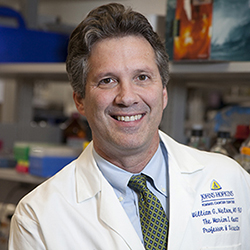Cancer Research: Back to Basics
Guest Post by William G. Nelson, MD, PhD
Editor-in-Chief, Cancer Today
Many types of cancer are caused by gene mutations acquired during a person’s lifetime. Systematic cataloging of these acquired gene defects has led to improved screening, detection, diagnosis, prevention, and treatment.
Next-generation genome sequencing, which quickly delivers an inventory of all defective genes in cancer cells or tissues, has streamlined drug development. As a result, new cancer treatments can be introduced and evaluated more rapidly and reliably. More efficient development of cancer treatments is paying off: The FDA approved 13 oncology drugs in 2013, 10 in 2014, and 17 in 2015.
To make the best use of cancer genome sequencing, basic research into all 20,000 human genes is needed to better understand how they form normal cells and tissue and how dysfunctional genes create cancers. This discovery research is vital for finding the ultimate cure for cancer.
The best discovery research is unfettered, driven by intellectual curiosity and conceptual advancement. As an example, research in the 1970s by Christiane Nüsslein-Volhard and Eric Wieschaus on how a fertilized fruit fly egg can give rise to a complicated segmented larva with a defined head and tail seemed a far cry from cancer research. Yet this seemingly unrelated avenue of research ultimately led to an effective cancer treatment.
Over the years the desire to understand how body segments and appendages form during embryonic development sparked interest in a large number of researchers. Among them was Philip Beachy, who focused on a fruit fly gene called hedgehog, which if defective makes fly embryos look stubby and hairy (like a hedgehog). Beachy later found that when one of the three hedgehog genes in mammals, called sonic hedgehog, was faulty, mice exhibited marked defects, such as the presence of a single eye. Beachy and his research team realized this “cyclops” deformity was similar to defects seen in offspring of livestock that graze on corn lilies, attributed to a steroid-like corn-lily chemical called cyclopamine. Sure enough, cyclopamine was found to disrupt sonic hedgehog-associated processes.
Sonic hedgehog and cyclopamine might have remained of interest only to researchers studying embryonic development and birth defects until overactivity of hedgehog-associated signaling was found to be responsible for many cases of basal cell carcinoma of the skin and of medulloblastoma in the central nervous system. The intense hedgehog signaling in these cancers was a result of acquired defects in hedgehog-related genes. Cyclopamine and related compounds inhibited the hedgehog signaling and stopped the cancer growth. In 2012, the FDA approved a hedgehog antagonist, vismodegib (Erivedge), to treat basal cell carcinoma.
Imagine if researchers had not studied hedgehog signaling in fruit flies and mice before genome sequencing revealed frequent mutations in the hedgehog-related genes in basal cell cancers and medulloblastomas. There would have been no rationale to create a drug like vismodegib.
More such discovery research is needed. Yet many worry that discovery research—largely supported by the National Institutes of Health and the National Science Foundation—may become critically underfunded. A more deliberate investment in discovery research could reveal more opportunities for developing cancer treatment.
William G. Nelson, MD, PhD, is the editor-in-chief of Cancer Today, the quarterly magazine for cancer patients, survivors, and caregivers published by the American Association for Cancer Research. Nelson is the Marion I. Knott professor of oncology and director of the Sidney Kimmel Comprehensive Cancer Center at Johns Hopkins in Baltimore. You can read his complete column in the spring 2016 issue of Cancer Today.





